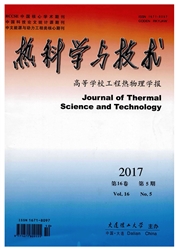

 中文摘要:
中文摘要:
经典状态方程虽然能够描述远临界区域的热力学性质,但由于临界区密度涨落的影响,无法精确描述流体在近临界的热力学性质。在简单的经典状态方程基础上引入跨接模型,使得跨接方程能够较好地描述流体近临界区和远临界区的热力学性质。以较为常用的PR方程为基础,比较了引入不同跨接模型(跨接正弦模型-1(CSM)、跨接解析正弦模型(ASM)和跨接正弦模型-2(NSM))后的跨接方程对丁烷、戊烷及己烷的相平衡和单相区性质的计算效果,发现PR/CSM方程和PR/ASM方程相平衡计算精度相当,优于PR/NSM方程,对于单相区性质,PR/ASM方程计算偏差最小,优于PR/CSM方程和PR/NSM方程,而且PR/ASM方程的跨接函数为显式函数的形式,简化了计算过程,使用更方便。
 英文摘要:
英文摘要:
Classical Equations of State(EoS)can represent thermodynamic properties in the regions far from the critical point. However,the classical EoSs fail to accurately predict thermodynamic properties in the critical region,because of the existence of large density fluctuations.The crossover technique is introduced to the original classical EoS to well represent thermodynamic properties both in the critical region and in the regions far from the critical point.Different crossover models(crossover sine model-1(CSM),analytical crossover sine model(ASM)and crossover sine model-2(NSM))are combined with the classical PR EoS.Comparisons are made among these crossover equations for the prediction of vapor-liquid equilibrium and pρT properties in single phase region.The results show that the calculated deviations of PR/CSM EoS and PR/ASM EoS for vapor-liquid equilibrium are much less than those of PR/NSM EoS.The calculated deviations of PR/ASM EoS for single phase behavior are less than those of PR/CSM EoS and PR/NSM EoS.Besides,the crossover function in the PR/ASM EoS is an analytical function,while the crossover functions of the other two EoSs are transcendental equations.More calculation time is saved and the calculation process is simplified,which make PR/ASM EoS easier to use.
 同期刊论文项目
同期刊论文项目
 同项目期刊论文
同项目期刊论文
 Effects of participating media on the time-resolved infrared measurements of wall temperature in a c
Effects of participating media on the time-resolved infrared measurements of wall temperature in a c Radiative properties and heat transfer characteristics of fiber-loaded silica aerogel composites for
Radiative properties and heat transfer characteristics of fiber-loaded silica aerogel composites for 期刊信息
期刊信息
